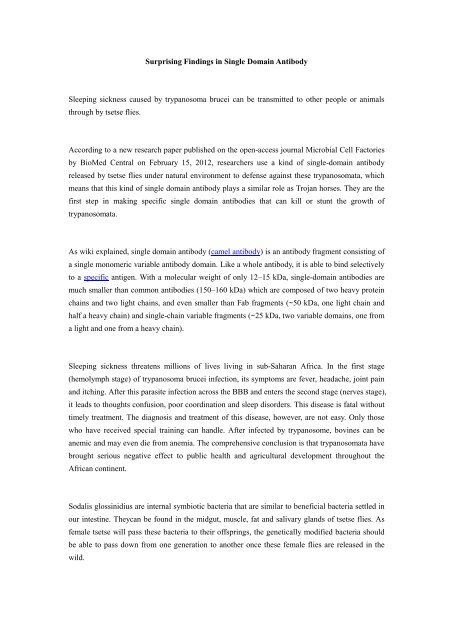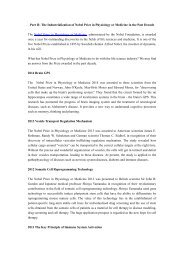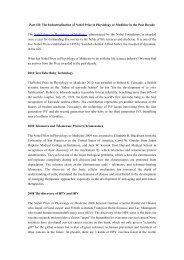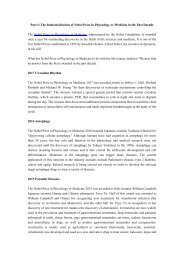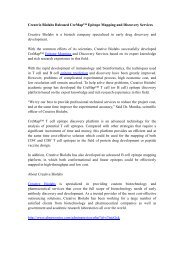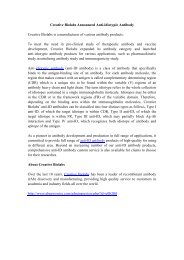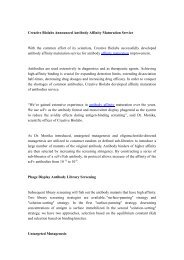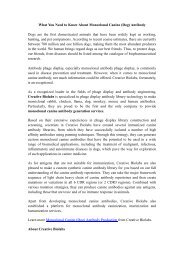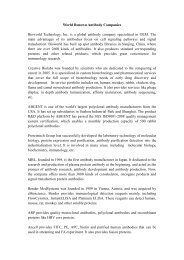Surprising Findings in Single Domain Antibody
Create successful ePaper yourself
Turn your PDF publications into a flip-book with our unique Google optimized e-Paper software.
<strong>Surpris<strong>in</strong>g</strong> <strong>F<strong>in</strong>d<strong>in</strong>gs</strong> <strong>in</strong> S<strong>in</strong>gle Doma<strong>in</strong> <strong>Antibody</strong><br />
Sleep<strong>in</strong>g sickness caused by trypanosoma brucei can be transmitted to other people or animals<br />
through by tsetse flies.<br />
Accord<strong>in</strong>g to a new research paper published on the open-access journal Microbial Cell Factories<br />
by BioMed Central on February 15, 2012, researchers use a k<strong>in</strong>d of s<strong>in</strong>gle-doma<strong>in</strong> antibody<br />
released by tsetse flies under natural environment to defense aga<strong>in</strong>st these trypanosomata, which<br />
means that this k<strong>in</strong>d of s<strong>in</strong>gle doma<strong>in</strong> antibody plays a similar role as Trojan horses. They are the<br />
first step <strong>in</strong> mak<strong>in</strong>g specific s<strong>in</strong>gle doma<strong>in</strong> antibodies that can kill or stunt the growth of<br />
trypanosomata.<br />
As wiki expla<strong>in</strong>ed, s<strong>in</strong>gle doma<strong>in</strong> antibody (camel antibody) is an antibody fragment consist<strong>in</strong>g of<br />
a s<strong>in</strong>gle monomeric variable antibody doma<strong>in</strong>. Like a whole antibody, it is able to b<strong>in</strong>d selectively<br />
to a specific antigen. With a molecular weight of only 12–15 kDa, s<strong>in</strong>gle-doma<strong>in</strong> antibodies are<br />
much smaller than common antibodies (150–160 kDa) which are composed of two heavy prote<strong>in</strong><br />
cha<strong>in</strong>s and two light cha<strong>in</strong>s, and even smaller than Fab fragments (~50 kDa, one light cha<strong>in</strong> and<br />
half a heavy cha<strong>in</strong>) and s<strong>in</strong>gle-cha<strong>in</strong> variable fragments (~25 kDa, two variable doma<strong>in</strong>s, one from<br />
a light and one from a heavy cha<strong>in</strong>).<br />
Sleep<strong>in</strong>g sickness threatens millions of lives liv<strong>in</strong>g <strong>in</strong> sub-Saharan Africa. In the first stage<br />
(hemolymph stage) of trypanosoma brucei <strong>in</strong>fection, its symptoms are fever, headache, jo<strong>in</strong>t pa<strong>in</strong><br />
and itch<strong>in</strong>g. After this parasite <strong>in</strong>fection across the BBB and enters the second stage (nerves stage),<br />
it leads to thoughts confusion, poor coord<strong>in</strong>ation and sleep disorders. This disease is fatal without<br />
timely treatment. The diagnosis and treatment of this disease, however, are not easy. Only those<br />
who have received special tra<strong>in</strong><strong>in</strong>g can handle. After <strong>in</strong>fected by trypanosome, bov<strong>in</strong>es can be<br />
anemic and may even die from anemia. The comprehensive conclusion is that trypanosomata have<br />
brought serious negative effect to public health and agricultural development throughout the<br />
African cont<strong>in</strong>ent.<br />
Sodalis gloss<strong>in</strong>idius are <strong>in</strong>ternal symbiotic bacteria that are similar to beneficial bacteria settled <strong>in</strong><br />
our <strong>in</strong>test<strong>in</strong>e. Theycan be found <strong>in</strong> the midgut, muscle, fat and salivary glands of tsetse flies. As<br />
female tsetse will pass these bacteria to their offspr<strong>in</strong>gs, the genetically modified bacteria should<br />
be able to pass down from one generation to another once these female flies are released <strong>in</strong> the<br />
wild.
Professor Van Den Abbeele, an expert from Antwerp Institute of Tropical Diseases, expla<strong>in</strong>ed,<br />
“When we study live trypanosomes <strong>in</strong>side the simulated <strong>in</strong>test<strong>in</strong>e of tsetse, we found that these<br />
genetically modified bacterium expressed s<strong>in</strong>gle doma<strong>in</strong> antibodies have biological activity and<br />
can b<strong>in</strong>d to the entire surface of the parasite. S<strong>in</strong>ce we know that this technology is effective, we<br />
are now study<strong>in</strong>g these s<strong>in</strong>gle doma<strong>in</strong> antibodies that can damage or block the development of this<br />
type of parasites <strong>in</strong> tsetse <strong>in</strong>test<strong>in</strong>e. “<br />
Epidemic Sleep<strong>in</strong>g sickness of these years first appeared <strong>in</strong> the 1970s. Although we have been<br />
try<strong>in</strong>g to decl<strong>in</strong>e the number of new cases <strong>in</strong> the past 10 years, this disease has not yet been<br />
eradicated. This new technology gives people hope to fight aga<strong>in</strong>st this devastat<strong>in</strong>g disease.<br />
About author<br />
Candy Swift is a reporter focus<strong>in</strong>g on bio-pharmaceutical <strong>in</strong>dustry. She is also a service consultant<br />
of Creative Biolabs.<br />
https://medium.com/@candyjkswift/surpris<strong>in</strong>g-f<strong>in</strong>d<strong>in</strong>gs-<strong>in</strong>-s<strong>in</strong>gle-doma<strong>in</strong>-antibody-dacada16fce<br />
5


